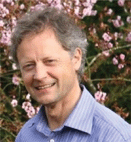DOI: 10.1039/C2CC90050E
(Profile)
Chem. Commun., 2012, 48, 4395-4396
Interview with Paul Beer
| ||||||
Do you remember what it felt like to publish your first ChemComm article?
Yes, my very first publication was a ChemComm (DOI: 10.1039/C39800000351) in 1980 and it resulted from the first three months of my PhD project which had begun well. Seeing my name in print was really exciting and stimulating; I remember giving copies of the paper to family and friends.How has your research evolved from your first to your most recent article?
My PhD topic of research was concerned with homogeneous catalysis using tricoordinate phosphorus catalysts in the dimerisation of activated alkenes. My PhD supervisor, Dr Dennis Hall, also had interests in macrocyclic chemistry and this influenced me to change research direction for postdoctoral research in supramolecular chemistry with Professor Jean-Marie Lehn. My most recent article (DOI: 10.1039/C1CC13247D) describes a redox-active [3]rotaxane host system capable of binding and electrochemically sensing chloride and sulfate anions. We are currently manipulating the unique topological cavities of mechanically bonded molecules for anion recognition and sensing applications. This also includes exploitation of the molecular machine-like dynamics of interlocked molecular systems as a means of functional sensor response. A recently awarded European Research Council Advanced Grant, in collaboration with colleagues Dr Jason Davis and Professor Stephen Faulkner, will help us develop this work further into switchable devices and imaging reagents.What do you like most about publishing in ChemComm?
ChemComm is an excellent vehicle for the rapid dissemination of high quality science to an international readership. The turnaround time is quick and free publishing in colour is a very attractive feature, especially in these times of financial restraint.What aspect of your research are you most excited about at the moment?
The integration of halogen bonding into interlocked host design is showing real promise in anion recognition and sensing applications. Halogen bonding is the non-covalent bonding interaction between halogen atoms which function as electrophilic centres (Lewis acids) and neutral or anionic Lewis bases. Of the many non-covalent interactions that are commonly utilized in supramolecular assemblies, halogen bonding is arguably the least exploited, which is surprising given its potentially powerful analogy to ubiquitous hydrogen bonding. During the past eighteen months or so we have demonstrated the first examples of solution phase halogen bonding being exploited to facilitate the anion templated assembly of interpenetrated and interlocked structures. Importantly, the incorporation of a halogen atom into a rotaxane and catenane host cavity dramatically influences and improves the anion recognition capabilities of the interlocked receptor. Combining anion supramolecular chemistry with nanoscience, we have also recently introduced a novel strategy for the preparation of structured bimetallic core@shell nanoparticles for catalytic applications.What is the best part of your job?
Although I like teaching, without doubt the best part of my job is my research. Scribbling down on paper ‘crazy’ ideas and discussing them with my group and colleagues is the most enjoyable aspect. I delight in going around the group chatting to individuals, sharing their excitement of isolating a new compound and, importantly, also keeping the motivation going when things do not work out in the laboratory. Observing how students mature, develop their research skills and find their independence is extremely rewarding.What is the secret to success in scientific publishing?
Research is about having an idea that works, develops and leads to new pathways and unexpected spin off discoveries. Creativity and imagination are essential ingredients.Scientific publishing is about recognizing good science and conveying it with as much clarity as possible.
What is your advice to young emerging scientists?
Above all, keep up with the literature and try not to get too downhearted when proposals are not funded. A lot of hard work, perseverance and determination is required in the first few years of academia to get the momentum going. Persist, and from time to time seek the advice of senior colleagues; you cannot beat the value of experience.What do you do in your spare time?
Visit art galleries, cathedrals and gardens for enjoyment and inspiration, ski in the Alps, exercise and run, and follow my favourite football team (Manchester United).By the time I'm 100 I would like to have…
…retired!| This journal is © The Royal Society of Chemistry 2012 |

